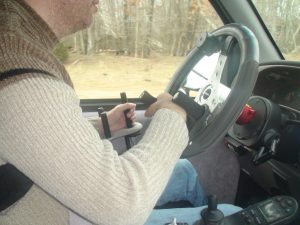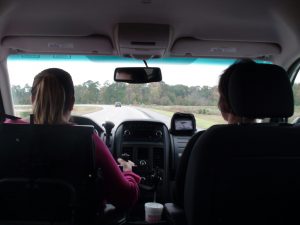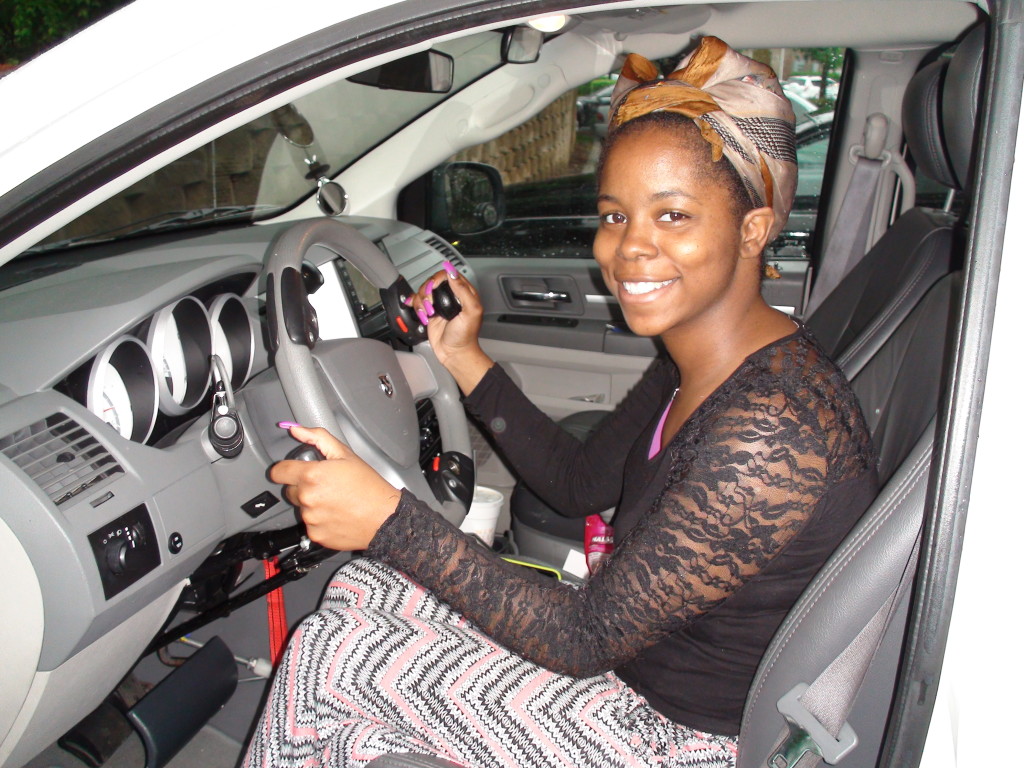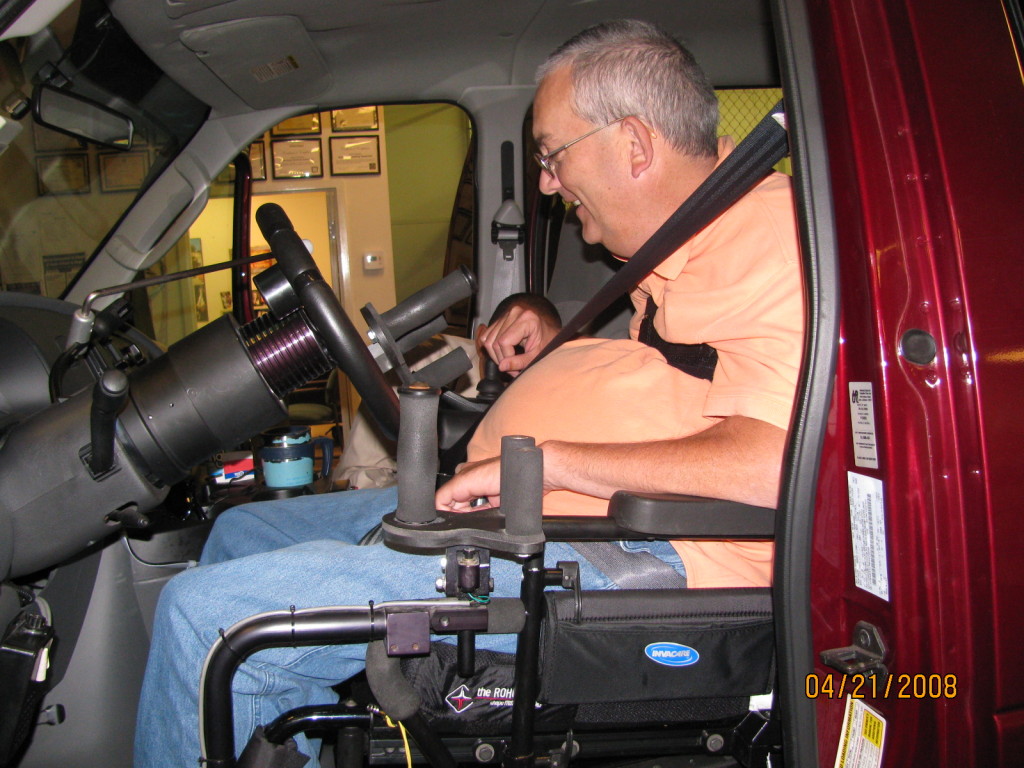Our process for assisting individuals who need to drive with adaptive equipment was created using Best Practice Guidelines as established by the National Association for Driver Rehabilitation Specialists.
STEP ONE:
Driver completes a comprehensive assessment with our Occupational Therapist/Certified Driver Rehabilitation Specialist to determine medical fitness, functional status, and appropriate equipment.The process begins with a comprehensive evaluation including clinical testing and behind the wheel trials of appropriate equipment. The clinical evaluation includes assessment of physical, visual, cognitive, and behavioral abilities. We have vehicles with different control options, multiple steering orthotics, a left foot accelerator and pedal extensions of various lengths for trial. A wheelchair accessible vehicle is available for individuals who may need to drive from a power wheelchair or transfer to a 6-way power seat.
An assessment concludes with:
a) A preliminary vehicle modification prescription for anticipated vehicle modification needs.
b) Initiation of communication with DMV medical evaluation program to start the process for getting the needed adaptive equipment endorsement on the license by STEP 4.
c) Training recommendations to assure safe use of the equipment
d) Counsel regarding appropriate stowage of mobility devices such as a walker or wheelchair
e) Guidance regarding proper interface of all controls and devices for modification in the client’s vehicle.
b) Initiation of communication with DMV medical evaluation program to start the process for getting the needed adaptive equipment endorsement on the license by STEP 4.
c) Training recommendations to assure safe use of the equipment
d) Counsel regarding appropriate stowage of mobility devices such as a walker or wheelchair
e) Guidance regarding proper interface of all controls and devices for modification in the client’s vehicle.
Evaluations are provided by appointment only at our clinic location, 5417 Frieden Church Road, McLeansville, NC.
STEP TWO:
Driver completes training to become proficient in the use of the adaptive controls.Training occurs in a DRS company vehicle set up with the equipment determined during the evaluation and specific to the client’s needs.
DRS vehicles have state required dual brakes, extra mirrors, and safety signage.
The driver gains confidence in the use of the adaptive driving controls and practices skills needed for independent control operation.
Training assures the person is making safe and independent decisions behind the wheel, judging space and time for merging, changing lanes, and parking, and incorporating consistent visual scanning.
Upon completion, a pre-modification training report is provided that endorses moving forward with a vehicle modification and includes a final vehicle prescription.
Training occurs at the driver’s location, in their usual driving environment, assuring safe and independent execution of familiar and frequented routes.
STEP THREE:
Driver begins vehicle modifications and participates in a vehicle fitting.Following training, a final vehicle prescription for adaptive controls is provided to the client and the client’s vehicle modifier. The vehicle modifier will provide the client with a cost quote and order the equipment.
The client, our Driver Rehab Specialist, and the vendor will establish a date and time for a vehicle fitting. Once modifications are underway the client, our Driver Rehab Specialist, and the vendor technician installing the adaptive controls will meet at the vehicle modifier’s shop to complete a vehicle fitting to assure that the controls are installed and positioned appropriately relative to the driver’s abilities. Adjustments will be made under the direction of our Driver Rehab Specialist. The vendor will require that they have the vehicle for a period of time prior to the fitting to allow for installation of the adaptive equipment. Sometimes 2 or 3 fittings are required, based on the individual's specific modifications.
Our Driver Rehab Specialist rides with the client at the modifier’s location so that the client may test the equipment and verify comfort level prior to taking the vehicle home.
Fittings are provided at the location of the chosen vehicle modification vendor.
STEP FOUR:
Driver completes final training in the newly modified vehicle.Final training is completed in the client’s modified vehicle and local driving environment to assure the client is proficient and comfortable navigating regular driving routes with the adaptive controls.
Final training includes a trip to the DMV for the client to pass a road test in his/her modified vehicle and obtain adaptive equipment restrictions on his/her license. This is required for the client to be legally endorsed by the State of NC to use adaptive equipment.
- Step One: Comprehensive Assessment
- Step 2: Training with Adaptive Equipment
Commonly Asked Questions about Driving with Adaptive Equipment
Can I get controls installed in my vehicle without ever having used the controls?Credible vehicle modification professionals follow best practice guidelines as set forth by the National Mobility Equipment Dealers Association (NMEDA). They will not install adaptive controls until assurance is reached that you are medically fit and safely trained to use the equipment. Therefore, individuals need to complete a comprehensive driver evaluation and specialized training for using the equipment prior to having equipment installed. This process allows for a final vehicle prescription to be provided to the vehicle modification vendor.
Can I purchase and install equipment myself?
Adaptive equipment affecting the primary gas, brake, and steering functions of the vehicle as well as the secondary functions like turn signals, gear selector, and wipers should be installed by a licensed and certified mechanic familiar with federal motor vehicle safety guidelines. This is imperative for the safety of roadway users.
Will my insurance cover the cost of an evaluation or training?
Private health insurance, Medicaid and Medicare do not cover the cost of evaluation and training services as driving is considered a privilege and not a medical necessity. Common funding sources include school systems for teen drivers, workers compensation providers, vocational rehabilitation services, independent living services, and private funding.
Can I use my own car for behind the wheel training?
Pre-vehicle modification training is completed in a company vehicle as the NC Division of Motor Vehicles requires that driving instruction be completed in vehicles equipped with dual brakes, extra mirrors and safety signage. This maximizes safety when learning a new way to drive. Once vehicle modifications have been completed, final training is provided in the client’s modified vehicle. Final training includes going to the DMV for the client to complete a road test and obtain adaptive equipment restrictions on his/her license.
Can I complete a driver evaluation or training if my license has expired?
No. You need to have a current license or permit to complete driving related services. If your license has expired, you can obtain a permit. Driver Rehabilitation Services will aid in training you with the adaptive controls to maximize success in passing the DMV road test and achieving licensure or updating your license with the proper restrictions for your required controls.
Does vehicle insurance cover my adaptive equipment?
You need to speak with your vehicle insurance carrier about any adaptive equipment installed in your vehicle. The insurance carrier should inform you as to what is required in order to obtain coverage for replacement of the equipment in case of an accident.
Can a non-disabled person drive my vehicle once it has been modified?
Most vehicles are able to be driven by an able-bodied individual using the regular accelerator and brake. Many hand controls have a lock-out feature to prevent use by a non-trained person. Other controls should simply be avoided by an able-bodied driver. On a rare occasion, equipment may have to be custom fit for a driver’s specific needs which may not allow for another individual to drive the vehicle. All effort is made to assure that the vehicle can also be driven in a typical manner.








